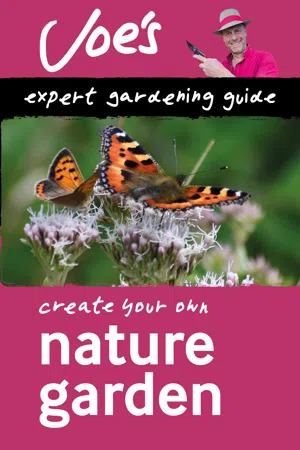Butterfly Life Cycle
The butterfly life cycle consists of four stages: egg, larva (caterpillar), pupa (chrysalis), and adult butterfly. The process begins when a female butterfly lays eggs on a host plant. The eggs hatch into caterpillars, which then undergo metamorphosis inside a chrysalis before emerging as adult butterflies. This transformation from egg to butterfly is a key aspect of the insect's life cycle.
4 Key excerpts on "Butterfly Life Cycle"
- eBook - ePub
Nature Garden
Create your own green space with this expert gardening guide
- Joe Swift, Collins Books(Authors)
- 2022(Publication Date)
- Collins(Publisher)
...Light pollution, an increase in paved areas and use of insecticides and pesticides are other factors too. © Shutterstock.com Life cycle The butterfly’s life cycle, called ‘metamorphosis’, is pretty complicated. They’re all different but here’s a basic timeline. They start as an egg, which takes around 5 to 10 days to hatch into a caterpillar. In the next 2 to 4 weeks, the caterpillar grows and then becomes a pupa (also known as a chrysalis). The pupal stage can last from 10 to 15 days, and then the adult butterfly emerges. Each of their life stages lasts a different amount of time depending on which species, but on average they have a life span of about two weeks in their adult stage; a painted lady’s complete cycle is one of the longest at around 12 months. Most breed in spring or summer and overwinter as a caterpillar although some get through the winter as an egg, pupa or adult butterfly – told you they were complicated and all unique! The thing is, at each stage they’re vulnerable so it’s not only nectar-rich plants we need to grow but also we need to provide habitats and perhaps change our gardening methods a little to accommodate them. © Shutterstock.com Butterflies Meadow brown Light-brown with distinctive eyespots on the wings (complete with white pupils) from June to September. Commonly seen in gardens, sometimes large groups flying together. The caterpillars love long meadow grasses (for feeding and habitats) and the butterflies are seen on many wild and garden flowers. Overwinters as a caterpillar. © Shutterstock.com Orange-tip The male has white wings with unmissable orange tips and the female has black wing tips on the tops. The undersides are altogether different: spotted green and white and clearly visible when resting. Seen early from April to July. Butterflies visit early-flowering plants like perennial wallflowers (Erysimum), cuckoo flower (Cardamine pratensis) and cow parsley. Garlic mustard is great food for the caterpillars...
- eBook - ePub
- Emanuele Coccia, Robin Mackay(Authors)
- 2021(Publication Date)
- Polity(Publisher)
...perfect egg, and ceasing from motion, it is like an egg, an animal potentially’. 22 The chrysalis, the cocoon built by the larva (also known as the pupation stage), is a kind of postnatal egg, and the life of insects is therefore that of an egg that builds other eggs. As Henson wrote in 1946, metamorphosis is ‘the repetition of the developmental cycle which occurs in embryogenesis’: 23 insect life is ‘a series of repeated developmental cycles all similar in essence to embryogenesis’. 24 According to this hypothesis (today shared by only some of the scientific community), metamorphosis is evidence that it is impossible for any living being to move away from the gestation stage. If it is by birth that we are destined to metamorphosis, metamorphosis also condemns all living things to remain part child: childhood can never leave us, and we will never be able to separate ourselves from it. To change form – to metamorphose – always means having the strength to turn one’s body into an egg capable of creating and bearing a new identity. Every self is an egg – and we are a self only because we harbour within us that metamorphic power of which every egg is the expression. It is as if metamorphosis makes it possible to internalize the capacity for gestation and to apply it not only to the other, but also to one’s own life. We are so obsessed with death, decadence, and decay that we no longer realize that every living being is a force of gestation – that every living being gives life to its own forms and to an infinity of others. Metamorphosis is first and foremost this power of all living things to nurture within themselves the capacity to vary the life that animates them. The egg, which insects liberate from its prenatal segregation, bringing it back in the midst of the life cycle, thus becomes the absolute medium, the intermediary between all the forms that life traverses and produces...
- eBook - ePub
- Anne Rooney(Author)
- 2016(Publication Date)
- Arcturus(Publisher)
...Chapter 17 How does a caterpillar turn into a butterfly? A caterpillar spins a cocoon and goes quiet for a few weeks. Then a butterfly emerges. How? What’s happening inside the cocoon? All change It seems one of the miracles of nature that an animal can completely transform before our eyes – or not before our eyes, as it’s hidden inside a cocoon. Many types of insect go through this change. At least with frogs we can see what happens as it’s all out in the open: legs grow, the tail shrinks, the gills shrink and (the bit we can’t see) the lungs develop. But what happens in the cocoon, called holometabolism, is hidden from view. Insect stages Insects begin life as eggs and hatch as grubs, maggots or caterpillars, which are all forms of larvae. The larvae feed and grow until they reach the point where they can move on to the next stage of development – pupation. They then produce strands of liquid protein which harden in the air to form fibres that the larvae spin into a cocoon. The cocoon can be soft or hard depending on the species of insect. Some forms of cocoon fibre are called silk and can be made into textiles for human clothing. During the time the insect is in the cocoon it’s vulnerable, as it can’t move. Its best defence is to be hidden. That is pretty much its only defence unless the cocoon is very hard or the insect itself is toxic to predators. Butterflies and moths often spin their cocoons somewhere out of sight, such as stuck to the underside of a leaf or hanging from the eaves of houses and sheds. Blowflies spin their cocoons in dark cracks and corners. Some moths even make their cocoons underground. After a period of a few weeks, or occasionally months, the next form of the insect emerges from the cocoon. It might bite its way through, or produce a chemical that softens the cocoon so that it can push its way out. Inside out Once the larva has spun its cocoon it is called a pupa and the whole caboodle – cocoon and pupa – is called a chrysalis...
- eBook - ePub
- Mark L. Winston(Author)
- 1991(Publication Date)
- Harvard University Press(Publisher)
...4 Development and Nutrition The process of growth and metamorphosis in bees involves some of the most complex interactions in a social insect colony. At the simplest level bee development can be examined from the perspective of a single bee, which must undergo a number of stages before finally emerging as an adult. But the metamorphosis from egg to adult is not unique to honey bees, and most insects go through a similar process. What separates social insects like honey bees from more solitary insects are the interactions that occur between the brood and adults, and it is these relationships that express many of the unique aspects of honey bee societies. The Life Cycle Development of all three castes involves a transition through four major stages: egg, larva, pupa, and adult (Fig. 4.1). The queen lays eggs in worker or drone cells; fertilized eggs can develop into either workers or queens, whereas unfertilized eggs usually develop into drones. The larval stage is the feeding time, when the bee gains an enormous amount of weight and grows tremendously in size. These two changes occur while cells are uncapped; the larvae spin their cocoons and change into pupae after adult workers have capped their cells. The pupal stage is one of metamorphosis, when the brood change into adults; when this transformation is complete, the teneral adult chews its way out of its cells and finishes developing during the next few days. The whole process from egg to adult can take as little as 16 days for queens, or as long as 24 days for drones. The development time as well as the quality of the emerged adult are particularly dependent on temperature, nutrition, and the race of bee. The development of bees in their cells has been reviewed by Jay (1963a); unless otherwise indicated, the data cited below have been drawn from that publication and references cited therein. Fig. 4.1 The four major stages in honey bee development...



